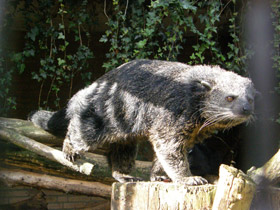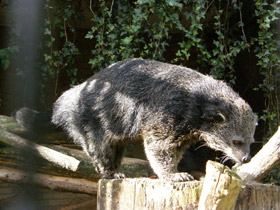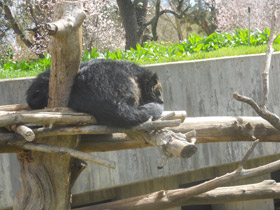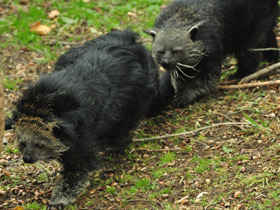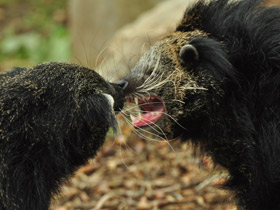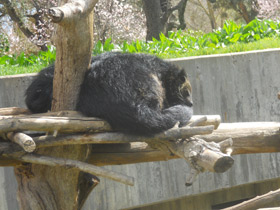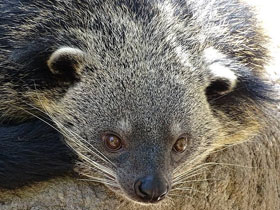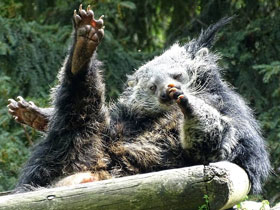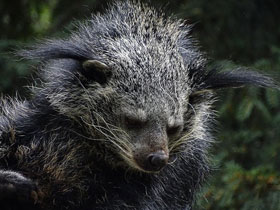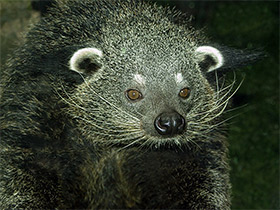The binturong (Arctictis binturong)
Binturong видео
 The binturong (Arctictis binturong) is included in the IUCN Red List as a "vulnerable species"
The binturong (Arctictis binturong) is included in the IUCN Red List as a "vulnerable species"
The binturong (Arctictis binturong) (/bɪnˈtjʊərɒŋ, ˈbɪntjʊrɒŋ/, bin-TURE-ong, BIN-ture-ong), also known as the bearcat, is a viverrid native to South and Southeast Asia. It is uncommon in much of its range, and has been assessed as Vulnerable on the IUCN Red List because of a declining population. It is estimated to have declined at least 30% since the mid-1980s. The binturong is the only species in the genus Arctictis.
Etymology
"Binturong" is its common name in Borneo, and is related to the Western Malayo-Polynesian root "ma-tuRun". In Riau, it is called "benturong" and "tenturun".
The scientific name Arctictis means 'bear-weasel', from the Greek arkt- "bear" + iktis "weasel".
Taxonomy
Viverra binturong was the scientific name proposed by Thomas Stamford Raffles in 1822 for a specimen from Malacca. The generic name Arctictis was proposed by Coenraad Jacob Temminck in 1824. Arctictis is a monotypic taxon; its morphology is similar to that of members of the genera Paradoxurus and Paguma.
In the 19th and 20th centuries, the following zoological specimens were described:
- Paradoxurus albifrons proposed by Frédéric Cuvier in 1822 was based on a drawing of a binturong from Bhutan prepared by Alfred Duvaucel.
- Arctictis penicillata by Temminck in 1835 were specimens from Sumatra and Java.
- Arctictis whitei proposed by Joel Asaph Allen in 1910 were skins of two female binturongs collected in Palawan Island in the Philippines.
- Arctictis pageli proposed by Ernst Schwarz in 1911 was a skin and skull of a female collected in northern Borneo.
- Arctictis gairdneri proposed by Oldfield Thomas in 1916 was a skull of a male binturong collected in southwestern Thailand.
- Arctictis niasensis proposed by Marcus Ward Lyon Jr. in 1916 was a binturong skin from Nias Island.
- Arctictis binturong kerkhoveni by Henri Jacob Victor Sody in 1936 was based on specimens from Bangka Island.
- Arctictis binturong menglaensis by Wang and Li in 1987 was based on specimens from the Yunnan Province in China.
Nine subspecies have been recognized forming two clades. The northern clade in mainland Asia is separated from the Sundaic clade by the Isthmus of Kra.
Appearance and habitat area
The binturong was described by Thomas Stamford Raffles in 1822. The genus Artictis is monotypic and morphologically similar to the genera Paradoxurus and Paguma. The name Arctictis means "bear-weasel" (from Greek "arktos", bear + "iktis", weasel). In Riau, Indonesia it is known as tenturun.
Arctictis binturong is very different from other members of the family Viverridae. It is a rather large animal: its length varies from 60 to 96 cm, its weight varies from 9 to 14 kg (sometimes even up to 20 kg) and it can be described as clumsy rather than fast and agile. Its coat is stiff and long, especially on the tail, dark grey or black. Distinctive features are its long white whiskers, long ear tassels and a grasping tail, unique among Old World mammals.
This predator is widespread in the lush tropical forests of Southeast Asia, from India to Sumatra, Java, Kalimantan and the Philippine island of Palawan.
Lifestyle and nutrition
Arctictis binturong lives exclusively in trees, sleeping on branches, with its legs dangling and clinging to a tree with its attached tail. Active at night, moving slowly and cautiously, Arctictis binturong does not jump from tree to tree, but with the help of its clawed tail it is able to climb perfectly, and is a good swimmer and diver. When it is on the ground, Arctictis binturong, like a bear, steps with its whole paw, which is also uncharacteristic for wyverns.
Unlike other representatives of the family, Arctictis binturong feeds mainly on plants (fresh fruits and shoots), but also eats small animals, birds and birds' eggs, and even fish, insects and carrion.
Social behaviour and reproduction
Arctictis binturong live singly or in small groups, consisting of a pair with young, females being the dominant sex. They produce young up to twice a year. Gestation lasts about 90 days and one to six young are born (on average two or three). After giving birth, the female allows the male to stay with her, which is unusual among wyverns. The young are weaned from milk at six to eight weeks of age and reach sexual maturity at two and a half years. Arctictis binturong are often kept as pets by natives, as they are easy to tame.
Threats
Major threats to the binturong are habitat loss and degradation of forests through logging and conversion of forests to non-forest land-uses throughout the binturong's range. Habitat loss has been severe in the lowlands of the Sundaic part of its range, and there is no evidence that the binturong uses the plantations that are largely replacing natural forest. In China, rampant deforestation and opportunistic logging practices have fragmented suitable habitat or eliminated sites altogether. In the Philippines, it is captured for the wildlife trade, and in the south of its range it is also taken for human consumption. In Laos, it is one of the most frequently displayed caged live carnivores and skins are traded frequently in at least Vientiane. In parts of Laos, it is considered a delicacy and also traded as a food item to Vietnam.
The Orang Asli of Malaysia has the tradition of keeping binturongs as pets.
Conservation
The binturong is included in CITES Appendix III and in Schedule I of the Indian Wild Life (Protection) Act, 1972, so that it has the highest level of protection. In China, it is listed as critically endangered. It is completely protected in Bangladesh, and partially in Thailand, Malaysia and Vietnam. Licensed hunting of binturong is allowed in Indonesia, and it is not protected in Brunei.
World Binturong Day is a yearly event held in several zoos and is dedicated to binturong awareness and conservation. It takes place every second Saturday of May.
In captivity
Binturongs are common in zoos, and captive individuals represent a source of genetic diversity essential for long-term conservation. Their geographic origin is either usually unknown, or they are offspring of several generations of captive-bred animals.









